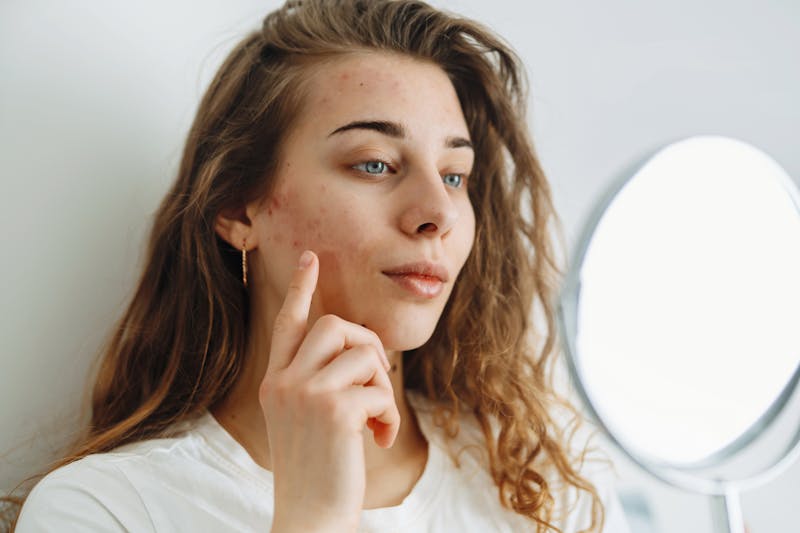
You aren’t alone if you’d hoped to leave acne behind in your adolescence. However, adult acne is something many adults struggle with into their 30s and beyond. Acne, breakouts, and the scars it leaves behind can leave you feeling self-conscious about your appearance—but there is hope!
Let’s dive into what acne is, why over-the-counter treatments don’t work, and how our aesthetic treatments can help.
What Is Acne?
We all know acne when we see it, but have you ever really considered what it is? Acne is a chronic inflammatory skin condition. Cysts, whiteheads, and blackheads form when your hair follicles become clogged with oil, dead skin cells, and bacteria. There are a variety of factors that lead to the increased oil production that contributes to acne.
Acne leaves your skin any combination of red, irritated, and inflamed. Even if it doesn’t hurt, you always know it’s there. You see it more than anyone else.
It often leaves behind scars that take years to fade. As they fade, new scars are left in their place—so your skin never clears up. Makeup can cover acne, but not everyone wants to wear full-coverage makeup daily. And many men prefer not to turn to makeup. Even with full coverage, acne remains without targeted intervention.
In addition to uneven skin tone, chronically increased oil production leaves pores looking enlarged. Some acne leaves small pits or deep craters, leaving the skin textured, not smooth.
What Causes Adult Acne?
When speaking of adult acne, genetics and hormones top the list, but you could have other contributing factors.
Genetics
Genetics plays a significant role in determining who gets acne. If your parents or older siblings had acne, you are more likely to experience it as well.
Hormonal Fluctuations
Hormonal changes are a primary cause of adult acne, particularly in women. These fluctuations can occur due to menstrual cycles, pregnancy, menopause, or conditions like polycystic ovary syndrome (PCOS). Androgens, male hormones present in both men and women, can increase oil production in the skin, leading to clogged pores and acne.
Stress
Stress triggers the release of cortisol and other hormones that can exacerbate acne. These hormones increase oil production and inflammation, making the skin more prone to breakouts. We discuss the difference between acne and breakouts below.
Skincare Products
Using the wrong skincare products can clog pores or irritate the skin. It's essential to choose non-comedogenic and gentle products, especially for those with acne-prone skin. If your skin is sensitive and acne-prone, clean products may be your best option.
Medications
Some medications, such as corticosteroids and certain birth control pills, can cause or worsen acne. On the flip side, some birth control pills can regulate hormones to improve acne. If acne develops within weeks or months of a new prescription or nutritional supplement, let your physician know. There may be another option.
Environmental Factors
Exposure to pollutants, humidity, and harsh weather conditions can affect the skin's health and contribute to acne. Additionally, frequently touching your face, a dirty smartphone, or a dirty pillowcase can transfer bacteria and oils to the skin, leading to breakouts.
Underlying Health Conditions
For most adults, acne has been chronic since puberty or occurs with easily explainable hormonal fluctuations. If your acne develops for no discernable reason, it could be a yet-to-be-diagnosed health condition. Certain health conditions, such as endocrine disorders, can manifest as acne. This is one of many reasons to have regular physicals and schedule appointments with any changes to your health, including your skin.
What Is The Difference Between Acne and Breakouts?
These two words are often used interchangeably, but they refer to two different (but similar) skin conditions. Understanding these differences can help you choose the appropriate treatment and skincare routine for your specific skin concerns.
Acne
Acne is a chronic skin condition characterized by the presence of various types of blemishes, including pimples, blackheads, whiteheads, cysts, and nodules. If you have acne, you have it every single day. This may be all over your face, in your t-zone, or on your chest or back.
Breakouts
Breakouts refer to the sudden short-term appearance of pimples or blemishes on the skin. You should be able to identify the root cause. For example, many women have breakouts the week or so before their menstrual cycle. Or you might have a breakout if you don’t wash off your makeup at night. Or you might break out under areas where sweat got trapped while working out or playing sports—like under your helmet, chin strap, or headband.
Key Differences
- Duration: Acne is a long-term condition, while breakouts are typically short-term.
- Severity: Acne can range from mild to severe and may include cysts and nodules, whereas breakouts usually involve milder forms of pimples.
- Causes: Acne has multiple underlying causes, including hormonal imbalances and genetics. Breakouts are often triggered by temporary factors.
- Treatment: Acne often requires a more comprehensive treatment plan, including prescription medications. Breakouts can usually be managed with over-the-counter products and lifestyle, skincare, and hygienic adjustments.
What Skin Conditions Are Frequently Mistaken For Acne?
If you’re experiencing what you thought was acne or a breakout, but it isn’t going away, or you have additional symptoms, it could be another skin condition.
Below are skin conditions often mistaken for adult acne:
Rosacea
Rosacea is a chronic skin condition that causes redness, swelling, and acne-like breakouts, primarily on the face. Unlike acne, rosacea often includes visible blood vessels and can cause a burning or stinging sensation. Treatment typically involves topical or oral medications and lifestyle changes to avoid triggers.
Folliculitis
Folliculitis occurs when hair follicles become inflamed, often due to bacterial or fungal infections. It appears as small, red bumps or white-headed pimples around hair follicles. Treatment may include antibacterial or antifungal medications, depending on the cause.
Perioral Dermatitis
Perioral dermatitis is a facial rash that tends to occur around the mouth, nose, and eyes. It’s symptoms include red, bumpy, and sometimes scaly patches. This condition is often triggered by topical steroids, certain skincare products, or hormonal changes. Treatment usually involves discontinuing the use of triggering products and using prescribed topical or oral antibiotics.
Keratosis Pilaris
Keratosis pilaris is a common, harmless skin condition that causes rough, small bumps, often on the arms, thighs, cheeks, or buttocks. These bumps are caused by a buildup of keratin, a protein that protects the skin. Moisturizing and exfoliating treatments can help manage this condition.
Sebaceous Hyperplasia
Sebaceous hyperplasia occurs when sebaceous glands become enlarged, leading to small, yellowish bumps on the skin, often mistaken for adult acne. These bumps are usually harmless but can be treated with topical treatments or minor surgical procedures if desired.
Hidradenitis Suppurativa
Hidradenitis suppurativa is a chronic skin condition characterized by painful, swollen lumps under the skin, often in areas where skin rubs together, such as the armpits and groin. These lumps can become infected and form abscesses. Treatment typically involves antibiotics, anti-inflammatory medications, and sometimes surgical intervention.
Contact Dermatitis
Contact dermatitis is an allergic or irritant reaction that causes red, itchy, and sometimes blistered skin. It can be triggered by exposure to certain chemicals, skincare products, or allergens. Identifying and avoiding the trigger is crucial, and treatment may include topical steroids and moisturizers.
Milia
Milia are small, white cysts that form when dead skin cells become trapped under the skin's surface. They are commonly found around the eyes and cheeks and are often mistaken for whiteheads. Milia usually resolve on their own, but they can be removed by a dermatologist if necessary.
How to Cope With Adult Acne?
Don’t go adult acne alone! Most over-the-counter acne treatments are designed to address adolescent acne. Many are made of harsh ingredients that can irritate and inflame your skin. It’s not uncommon for the products that worked in your teens and 20s, to no longer work as an adult. Instead of investing your time and money going it alone, schedule an appointment with a dermatologist.
A dermatologist can prescribe treatments that can drastically improve your acne. Sometimes the improvement is rapid and sometimes it’s gradual. Be patient and consistent.
How To Treat Acne Scarring?
The confidence boost of getting your acne under control can be dimmed if you don’t also address your scars and craters. Valley Medical Weight Loss and Med Spa is here to help!
We offer a variety of aesthetic solutions to fade acne scars and redness, and a few options to smooth and rejuvenate textured skin.
Intense Pulsed Light
Lumecca intense pulsed light (IPL) therapy takes a 3-pronged approach to acne. First, it fades the scars left behind from your acne and breakouts. Second, it minimizes the redness caused by acne. Third, it minimizes enlarged pores, reducing your need for pore-reducing products, most of which exacerbate your skin’s irritation.
Platelet-Rich Fibrin
Platelet-rich fibrin (PRF) treatments have revolutionized how we treat acne pockmarks. A small vial of your own blood is drawn, comparable to what’s required for a routine blood test. The blood is placed in a centrifuge machine, where it’s spun at high speeds. This spinning process isolates the plasma, creating a concentrated mix of platelets and other growth factors. It’s then strategically injected into your skin to stimulate your body’s natural healing response.
In addition to smoothing your scarred skin over the next 4 to 6 weeks, the treatment stimulates collagen and elastin production. This provides the anti-aging benefit of minimizing the appearance of fine lines and wrinkles.
Ready to Rejuvenate Your Acne-Scarred Skin?
Valley Medical Weight Loss and Med Spa offers a variety of skincare treatments to help teens and adults with their acne-scarred skin. We’ll advise on which treatment is right to address your needs. Several treatments may be required, especially if your adult acne has yet to be resolved.
Reach out to learn more!

